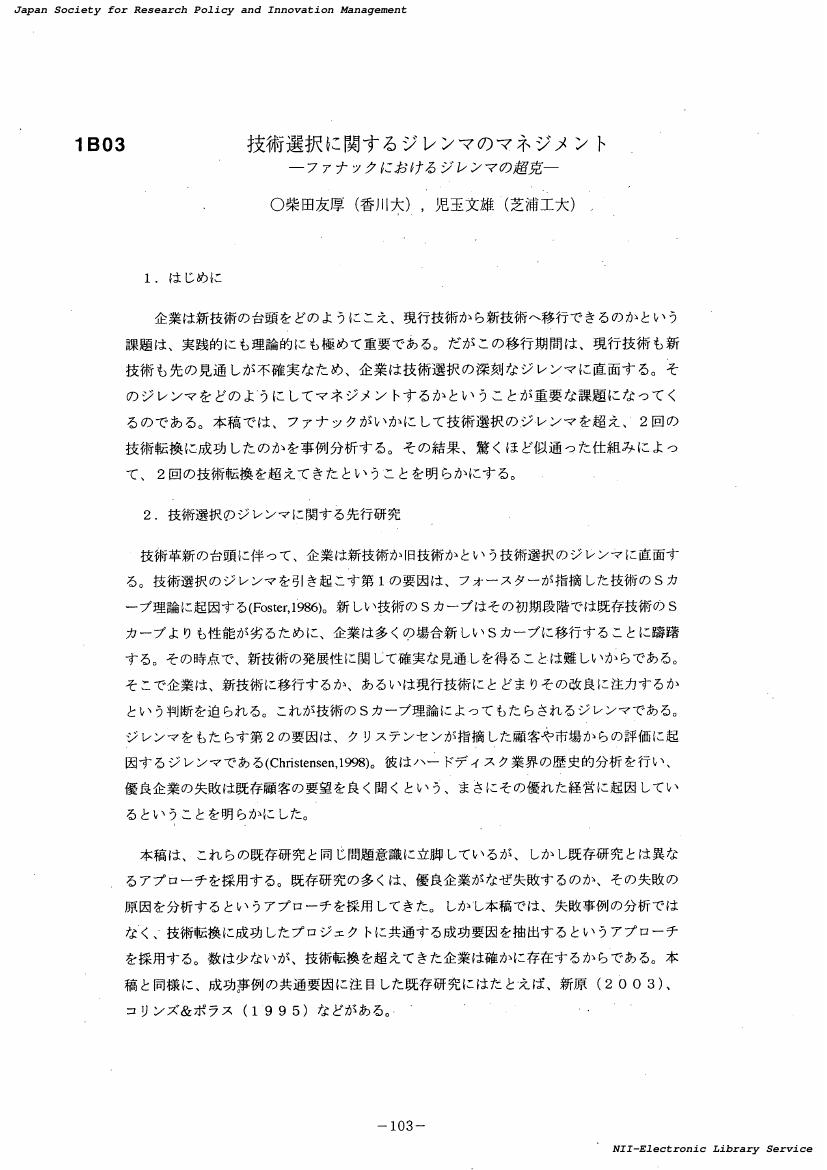- 著者
- 茅 明子 奥和田 久美
- 出版者
- 研究・イノベーション学会
- 雑誌
- 年次大会講演要旨集 29 (ISSN:24327131)
- 巻号頁・発行日
- pp.109-112, 2014-10-18 (Released:2018-01-30)
- 著者
- 秋吉 貴雄
- 出版者
- 研究・イノベーション学会
- 雑誌
- 研究 技術 計画 (ISSN:09147020)
- 巻号頁・発行日
- vol.28, no.1, pp.37-48, 2013-09-30 (Released:2017-10-21)
The aim of this article is to consider the implications for "Science of Science, Technology and Innovation Policy" from the viewpoints of Policy Sciences. Policy Study was started as "Policy Sciences" to improve policymaking system by providing two knowledge, knowledge of process and knowledge in process. At first, Policy Study had the "preference for automation", which remove politics from policymaking process. Several reforms, such as PPBS, have been done, but these reforms could not succeed. Facing these failures, Policy Study has tried to develop new analytical frameworks based on post positivism. And these experiences showed the implications for "Science of Science, Technology and Innovation Policy", especially on three phases. First, on the phase of analysis of policy problem, Policy Study examined the methods and process of problem structuring, and also pointed out the importance of framing to recognize and define the problem. Second, on the phase of making of policy alternatives, Policy Study pointed out the existence of three types of knowledge to form policy alternatives and developed the frameworks of policy analysis to use local knowledge. Third, on the phase of knowledge utilization, Policy Study showed the notion of policy learning and examined the institutional constraints on policymaking.
2 0 0 0 OA 企業におけるシナリオ・ライティング手法の活用
- 著者
- 村上 路一
- 出版者
- 研究・イノベーション学会
- 雑誌
- 研究技術計画 (ISSN:09147020)
- 巻号頁・発行日
- vol.4, no.2, pp.171-176, 1989-09-10
シナリオ・ライティング手法は、描写性とストーリー性が優れているため、他の技術予測手法に比べ、相手が興味を持ち、しかも理解し易いという特長がある。 このため、たんに技術予測のためだけに使用するのではなく、システム製品の販売や社内制度変更のためのツールとしても役立つことが明確になってきた。 本報告では、これらについて実例を挙げながらシナリオ・ライティング手法の書き方と企業における応用について述べる。
- 著者
- 渡辺 千仭 藤 祐司
- 出版者
- 研究・イノベーション学会
- 雑誌
- 研究技術計画 (ISSN:09147020)
- 巻号頁・発行日
- vol.16, no.3, pp.184-202, 2003-09-19
- 被引用文献数
- 1
日本の技術と経済の好循環は,企業の旺盛な研究開発投資に支えられた技術革新によるものである。そして「日本的経営システム」には,若年労働者の賃金をその生産性以下におさえ,その差額を自らの将来の投資に向ける「見えざる出資]が存在しており,これが研究開発投資をはじめとする,長期の不確実性を有する投資の誘発に少なからぬ役割を果たした。この「見えざる出資」は自社内従業員から間接的に負担を求める点で社員持ち株制度(ストックオプション)と類似しているが,株式発行による資金調達と異なり,経営主体独自の判断で運用することができる日本固有の精妙なシステムである。しかし,1990年代のバブル経済の崩壊と軌を一にした低・マイナス成長や高齢化等のパラダイム変化とともに,「見えざる出資」の機能が低下するに至っている。昨今の研究開発投資離れは,これと無縁ではない。本研究においては,1980年までの日本経済のパフォーマンスと1990年代以降のそれとの好対照に視点を据えて,製造業主要業種の「見えざる出資」及び資本コストに占める研究開発投資の位置付け等の計測をベースに,以上の仮説的見解の実証を試みる。その結果,「見えざる出資」が,『若年期の賃金抑制→企業の内部留保蓄積→設備投資増加→企業成長→中高年の高賃金支払い』といったメカニズムを通じて企業成長力の原動力となっていることを示した。しかし,近年の高齢化・少子化・低,ゼロ成長等のパラダイム変化に伴い,企業側にとって上記メカニズムの持つメリットが失われてきていることもまた明らかであり,これからの技術形成に対する姿勢は,研究開発投資額の増大よりも,より効率的な投資を可能とするシステムの構築が重要となることを示した。
- 著者
- 柴田 友厚 児玉 文雄
- 出版者
- 研究・イノベーション学会
- 雑誌
- 年次大会講演要旨集 19 (ISSN:24327131)
- 巻号頁・発行日
- pp.103-106, 2004-10-15 (Released:2018-01-30)
- 著者
- 藤垣 裕子
- 出版者
- 研究・イノベーション学会
- 雑誌
- 研究 技術 計画 (ISSN:09147020)
- 巻号頁・発行日
- vol.21, no.2, pp.149-155, 2007
- 参考文献数
- 19
The article reviews scientometrics as a methodology for policy science. Science and technology policy necessitates measurement and evaluation of the current scientific activities in order to develop future steps. Scientometrics, which studies methods, objects and effectiveness of measuring scientific activities, should therefore be an important constituent of policy science. The term "scientometrics" was coined after "psychometrics" and "sociometrics", which share quantitative view of the subject of study. The present work first shows how scientometrics differs from bibliometrics or library and information science to indicate the need of a theory on what aspect of scientific activity is measured quantitatively. It then presents a historical overview of scientometrics in four phases: pre-history, establishment of the principle, development and institutionalization of indicators, and application to evaluation. The article further reviews practical methods including analysis of the number of reports, citation and co-citation analysis, term and co-term analysis, and forming and combination of indicators. Discussion on the possibility of and potential issues on quantification concludes the article.
2 0 0 0 OA コンソーシアム型による実用化技術の研究開発プロジェクトに関するネットワーク分析
- 著者
- 野間口 隆郎 山崎 晃 林田 英樹 舩島 洋紀 高橋 雅和
- 出版者
- 研究・イノベーション学会
- 雑誌
- 年次学術大会講演要旨集
- 巻号頁・発行日
- vol.32, pp.380-383, 2017-10-28
一般講演要旨
2 0 0 0 OA デジタル経済下でのGDP計測 : Uncaptured GDPの実相と国際対応
- 著者
- 藤 祐司 渡辺 千仭 岩見 紫乃
- 出版者
- 研究・イノベーション学会
- 雑誌
- 年次学術大会講演要旨集
- 巻号頁・発行日
- vol.32, pp.55-60, 2017-10-28
一般講演要旨
2 0 0 0 ジェネンテック社におけるイノベーションのダイナミクス
- 著者
- 石川 雅敏
- 出版者
- 研究・イノベーション学会
- 雑誌
- 研究 技術 計画 (ISSN:09147020)
- 巻号頁・発行日
- vol.22, no.3, pp.212-219, 2008
- 参考文献数
- 20
本論文では,ジェネンテック社におけるバイオテクノロジーを基礎とした医薬品開発の過程を振り返り,ジェネンテック社におけるイノベーション・ダイナミクスについて考察した。ジェネンテック社は1980年前後に遺伝子組換え技術を発明した。この遺伝子組換え技術を用いることによって,ジェネンテック社は,数多くの遺伝子組換え医薬品を発明することに成功した。ジェネンテック社は,さらに遺伝子組換え技術から抗体技術を開発した。そして,抗体技術を用いることによって,さらに連続的に抗体医薬品を開発することに成功した。このような特徴的なイノベーションのダイナミクスによって,ジェネンテック社は連続的な医薬品開発に成功したと考えられた。ジェネンテック社におけるイノベーションのダイナミクスは,アッターバックがタイプライター産業において報告したイノベーション・ダイナミクスとは異なる方向性のダイナミクスである。
2 0 0 0 OA パターン・ランゲージを用いたプロジェクトマネジメント経験知の共有法について
- 著者
- 峯尾 岳大
- 出版者
- 研究・イノベーション学会
- 雑誌
- 年次学術大会講演要旨集
- 巻号頁・発行日
- vol.32, pp.801-804, 2017-10-28
一般講演要旨
2 0 0 0 OA 構造方程式モデリングに基づく公的な学際・融合研究開発プロジェクトの構造の特定
- 著者
- 宮下 修人 仙石 慎太郎 安西 智宏
- 出版者
- 研究・イノベーション学会
- 雑誌
- 年次学術大会講演要旨集
- 巻号頁・発行日
- vol.32, pp.816-820, 2017-10-28
一般講演要旨
2 0 0 0 OA 特許による国内研究機関の論文の引用 : 指標の性質の検討
- 著者
- 山下 泰弘 治部 眞里
- 出版者
- 研究・イノベーション学会
- 雑誌
- 年次学術大会講演要旨集
- 巻号頁・発行日
- vol.32, pp.530-533, 2017-10-28
一般講演要旨
- 著者
- 原 泰史 小柴 等 池内 健太
- 出版者
- 研究・イノベーション学会
- 雑誌
- 年次学術大会講演要旨集
- 巻号頁・発行日
- vol.32, pp.483-486, 2017-10-28
一般講演要旨
2 0 0 0 OA 機能性食品の適正製造規範の有効性と課題
- 著者
- 佐藤 圭吾 池田 秀子 児玉 耕太 仙石 慎太郎
- 出版者
- 研究・イノベーション学会
- 雑誌
- 年次学術大会講演要旨集
- 巻号頁・発行日
- vol.32, pp.505-509, 2017-10-28
一般講演要旨
- 著者
- 岩本 隆 髙橋 美寿
- 出版者
- 研究・イノベーション学会
- 雑誌
- 年次学術大会講演要旨集
- 巻号頁・発行日
- vol.32, pp.460-463, 2017-10-28
一般講演要旨
- 著者
- 関本 奈菜子 妹尾 堅一郎 伊澤 久美 上野 洋和 丸島 和也 大沼 妙子
- 出版者
- 研究・イノベーション学会
- 雑誌
- 年次学術大会講演要旨集
- 巻号頁・発行日
- vol.32, pp.414-417, 2017-10-28
一般講演要旨
- 著者
- 小林 信一 榎 孝浩
- 出版者
- 研究・イノベーション学会
- 雑誌
- 年次大会講演要旨集
- 巻号頁・発行日
- vol.30, pp.584-587, 2015
- 著者
- 後藤 芳一 松森 ハルミ 星川 安之
- 出版者
- 研究・イノベーション学会
- 雑誌
- 年次学術大会講演要旨集
- 巻号頁・発行日
- vol.32, pp.229-232, 2017-10-28
一般講演要旨
2 0 0 0 OA 再生可能エネルギーを使った地域活性化事業の経済的・社会的インパクト評価
- 著者
- 三森 八重子
- 出版者
- 研究・イノベーション学会
- 雑誌
- 年次学術大会講演要旨集
- 巻号頁・発行日
- vol.32, pp.130-133, 2017-10-28
一般講演要旨
2 0 0 0 OA 地域活性化を目指した自立分散電源やEMSへの取り組み
- 著者
- 安田 昌司 奥 健夫 池本 未和
- 出版者
- 研究・イノベーション学会
- 雑誌
- 年次学術大会講演要旨集
- 巻号頁・発行日
- vol.32, pp.122-125, 2017-10-28
一般講演要旨



